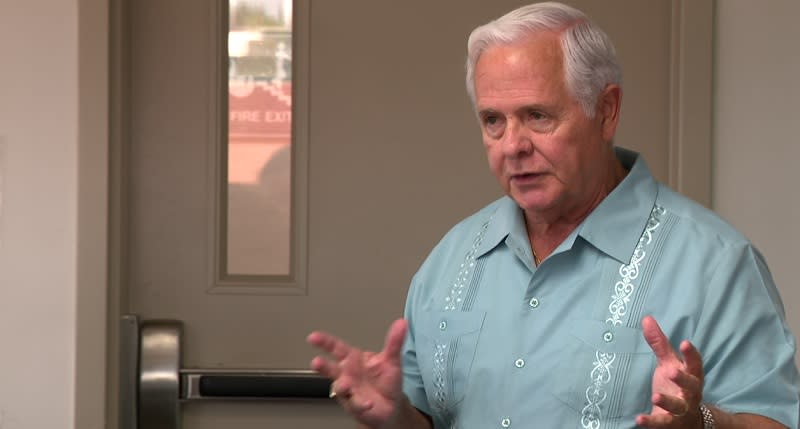Oregon wonders what today’s ‘insane asylum’ looks like
Editor’s Note: This is the final report in the KOIN 6 News series, “Breaking the Cycle: Oregon’s attempt at recovery”
PORTLAND, Ore. (KOIN) — Dan Garris shared the trials and tribulations his daughter Alexa faces with state leaders in Salem.
“We have a 32-year-old daughter who has suffered for many, many years under the weight of some ups and downs in her mental illness,” Garris said. “She lives in a world of delusion. A lot of the time she has some form of severe schizophrenia, sometimes psychosis.”
During Alexa’s harrowing battle with addiction and severe mental illness, she has repeatedly cycled through mental health and the criminal justice systems.


Garris is a fierce advocate for his adult daughter — and for others like her who need lifelong care.
“It’s no excuse for letting somebody go back out on the streets when they need the highest level of care,” he said. “I just wonder why safety and security and dignity for the severely mentally ill has to be so hard to achieve in a civil society.”
Oregon lawmakers sympathize with Dan Garris.
State Rep. Kevin Mannix, who serves Keizer and North Salem, sits on the new Addiction and Community Safety Committee. Lawmakers recently set up this bicameral, bipartisan committee, which already met in October and November. They’re also meeting in December and January – which is not something they usually do.
However, Mannix and his fellow lawmakers are gathering ideas about how to handle these problems and aim to pass new bills in the short legislative session scheduled for February.
“Dan’s story is heart wrenching. It’s just a reflection of a systemic failure of our state,” Mannix said.

He’s already eyeing the Dome Building — which is right across the street from the Oregon State Hospital.
“It is a building that has everything you need in terms of heat, lighting, plumbing,” Mannix told KOIN 6 News.
The empty, state-owned, 67,000-square foot property could care for 400 mentally ill people, Mannix said.
“My message to the governor and to my fellow lawmakers is please convene the emergency board. Please have the emergency board allocate the necessary funds to reopen the Dome Building as a state hospital facility and to bring in emergency staffing,” he said. “It may not be fully occupied. It could be partially occupied to address the mental health and criminal justice crisis we have confronting us right now.”
Mannix claims the state insists they’d need to spend $10 million and many months to make the the Dome Building earthquake-proof first.
“Instead of saying we’re going to vacate it, let’s use it now and worry about the earthquake plan for the future, not for right now, because what we have is a community need today.”
Regardless, Mannix said the money is there.
“There is $471 million in additional revenue in this biennium that’s coming in that hasn’t been budgeted or spent. It’s extra money coming in and it could be dedicated to address these issues,” he said.
Other lawmakers, like Rep. Rob Nosse, see a longer road ahead.
Nosse represents inner Southeast and parts of Northeast Portland. Like Mannix, he also sits on the new Addiction and Community Safety Committee, plus he chairs the the Behavioral Health Committee.

He said prior legislative investments of $1.3 billion will result in 1,000 more beds for the mentally ill and addicted within communities across the state by July 2025. He said he “absolutely” feels there’s a need for long-lasting, long-term care for a small percentage of people who don’t have the capability to live independently.
“There’s no question,” Nosse told KOIN 6 News. “And I think that there’s a lot of my colleagues that want to support this kind of initiative. It’s figuring out what it is that we need to stand up. What does that look like? And then, honestly, how do we pay for it?”
He said ensuring adequate staffing for facilities remains a significant challenge. However the importance of high-quality staff can’t be overstated. It’s crucial to prevent a recurrence of the disturbing conditions seen at insane asylums of the past.
To Nosse a dignified space “means that we have a lot more housing that’s dedicated to people who are struggling with mental illness or disability that’s in the community that’s close by, that’s staffed by professionals, that pays a wage that’s competent for those professionals to be able to do a job and feel good about it and also not be living on the edges of poverty themselves.”
“And,” he added, “what I would say to that dad and his daughter is that there are lawmakers that are trying to figure this out.”
For instance, Governor Tina Kotek has established the Portland Central City Task Force to develop recommendations for addressing the city’s challenges. The recommendations will become fully public on December 11.
Some ideas include recommendations to immediately add roughly 250 more residential treatment facility and psychiatric beds, like discussed in part 3 of this series.
The governor has also been a vocal proponent of creating new laws to criminalize public use of hard drugs as something she wants to address in the upcoming session. She and fellow lawmakers want to make it uncomfortable for people to be selling fentanyl out in the open.
Dads, like Dan Garris, are waiting.
“I’m reminded of all the other parents of all the broken daughters and all the hurt, injured, mentally injured sons who have grieved and fought,” Garris said. “They’ve fallen just like we have. They’ve gotten back up and they continue to advocate — and I want to say to all of them, you are not alone.”
Garris is waiting for the day Oregon sees what true compassion is, moving beyond bleak institutions or holding tanks for the mentally ill and no longer abandoning them on the streets. Instead, there would be dignified, secure spaces that provide exceptional individuals a chance at a purposeful life.
Ward 81 in 1976
Photographs by Mary Ellen Mark | Text by Karen Folger Jacobs | Published by Steidl
Images within the book Ward 81, capture the inhumane conditions of a secure facility for women at the Oregon State Mental Institution in 1976. It was the sole locked ward for females in the state. The individuals within this ward were deemed a risk to themselves or others by a judge. Over a span of just over a month, Mary Ellen Mark and Karen Jacobs immersed themselves into the institution, living in nearby cells in an empty, adjacent ward.
Courtesy: Ward 81: photographs by Mary Ellen Mark | text by Karen Folger Jacobs with an introduction by Milos Forman | published by Steidl Courtesy: Ward 81: photographs by Mary Ellen Mark | text by Karen Folger Jacobs with an introduction by Milos Forman | published by Steidl Courtesy: Ward 81: photographs by Mary Ellen Mark | text by Karen Folger Jacobs with an introduction by Milos Forman | published by Steidl Courtesy: Ward 81: photographs by Mary Ellen Mark | text by Karen Folger Jacobs with an introduction by Milos Forman | published by Steidl Courtesy: Ward 81: photographs by Mary Ellen Mark | text by Karen Folger Jacobs with an introduction by Milos Forman | published by Steidl Courtesy: Ward 81: photographs by Mary Ellen Mark | text by Karen Folger Jacobs with an introduction by Milos Forman | published by Steidl
During their days there, they documented the lives of the patients, establishing personal connections. Through a series of photographs and conversations, they unveil unsettling realities within mental institutions, depicting electroshock therapy sessions and the stark isolation experienced by the residents.
The chronicle details the women’s disturbances, difficulties and delusions, giving a glimpse into what their mental illness may be without ever fully revealing diagnoses. But what becomes abundantly clear, is that even in this confused state of mind, the ladies all possessed a strong desire to share love, conversation and connection with others.
During the time of writing this, Jacobs explained that the Carter administration discharged these individuals from hospitals with the intention of implementing community support and mental health services. Unfortunately, due to a lack of funding, the plan never materialized.
Consequently, these individuals were released without proper care and support. Later, she went in search of survivors and found out one young woman who lived in the ward (photographed on the front cover) was homeless and at the time had recently gotten in trouble for panhandling in southern Oregon.
“This is what happens to these people — they can’t make it,” Jacobs said.
View the first five stories in this series below.
Part 1: Relapse vs Recovery: Oregon’s reality of new street drugs
Part 2: Kidnapping attempt connects 2 dads, exposes untreated mental illness in Oregon
Part 3: WATCH: Oregon’s groundbreaking study reveals road to addiction recovery
Part 4: Despite controversy, Measure 110 ‘fills a great need’ for people with addiction
Part 5: Does Measure 110 need ‘a combination of coercion’?
For the latest news, weather, sports, and streaming video, head to KOIN.com.







